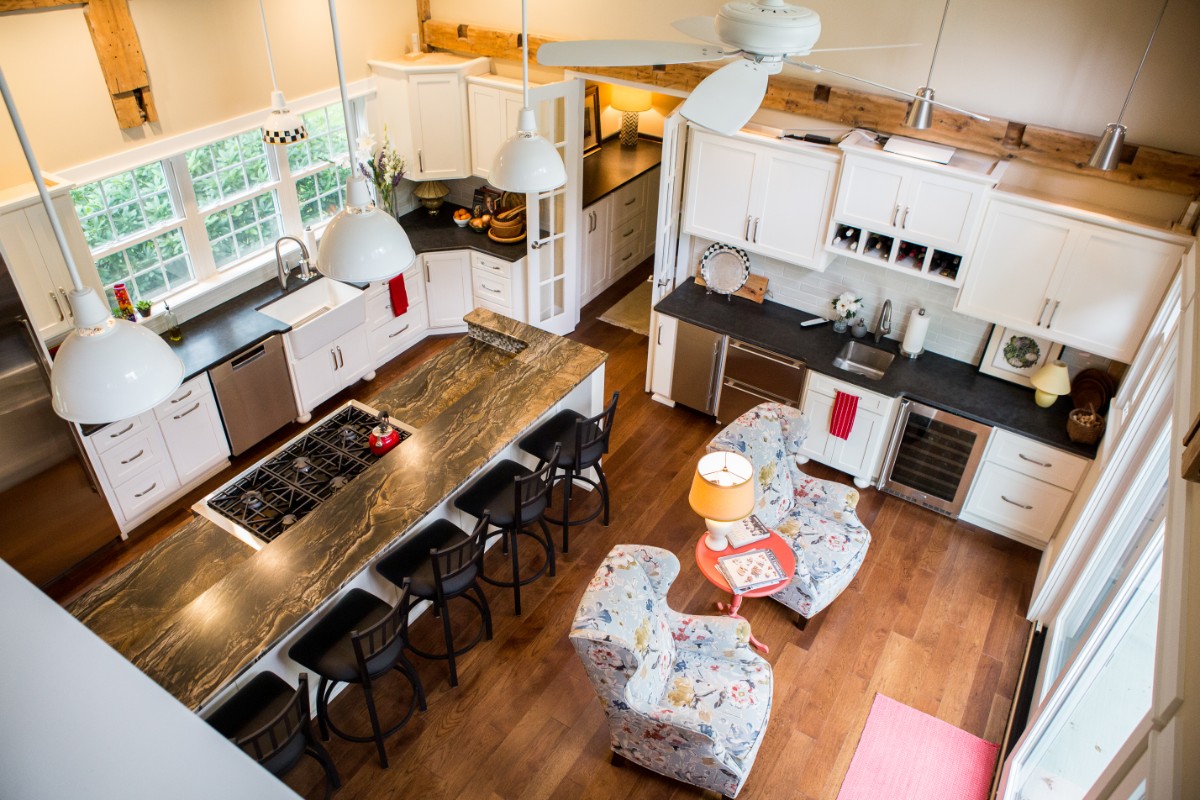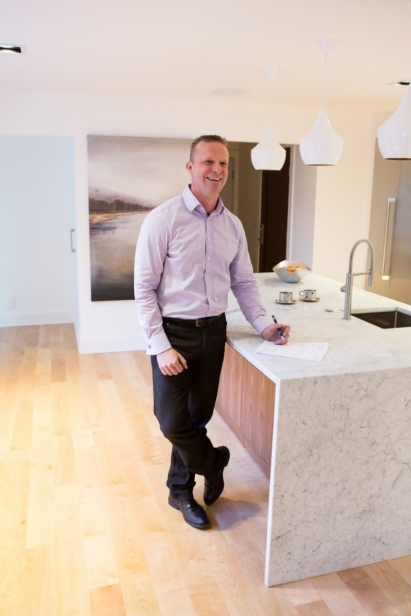13 Considerations When (Re)Modeling Your Kitchen
For some, redoing a kitchen may only require a fresh coat of paint and changing the hardware on cabinets. For others, it may require more. Or even much more. If your kitchen still sports avocado green appliances and an Amana Radar Range that you saw Bob Eubanks give away on “The Newlywed Game,” you’re probably in the latter category.
Now is perfect time to contemplate your wants and needs (and budget) before rolling up your sleeves to start demolition. Many elements including appliances, materials and even the role of the kitchen have changed enough to warrant thoughtful planning. Here are 13 things to consider that will save time, money, frustration, money, extra work and money.
1. Think about how long you plan to stay in your home and why you want to change your kitchen.
“When sellers ask me if it’s worth renovating, remodeling, or upgrading their kitchens for resale, and how much of the costs they can recoup from a higher sale price, I advise them to first look at upgrades,” says Howie Greene, realtor and salesperson with Charles Rutenberg Realty, Inc. With 10 years of experience selling homes in Western New York and the New York City metropolitan area, Green has found upgrades to be “much less expensive and stressful, and the results can lead to quickly closing a sale.”
However, if you’re looking to stay in your home, Greene points to the 2017 Home Improvement Survey by the National Association of Realtors. “After modernizing and making their kitchens more functional and livable, a whopping 91 percent surveyed have an increased sense of enjoyment in their home, with 89 percent feeling a sense of personal accomplishment,” he explains. “Sellers who do complete kitchen renovations can expect a 62 percent recovery of the costs when they sell their home.”
2. Consult the experts.
To find out what professionals recommend when considering a renovation, I spoke with Jennifer Hutton, Paul Marlinski and Rich Nashwinter.
Hutton is a sales and design consultant for Artisan Kitchens and Baths at Appliance Associates in Buffalo, with 10 years of kitchen and bath design experience.
Marlinski, owner of Design Concepts of WNY in Jamestown, is a contractor and self-professed foodie who has been advising homeowners in redoing their kitchens and baths for more than 35 years.
Nashwinter, of Nashwinter Designs in Buffalo, has 20 years of experience in all sorts of designs with an emphasis on kitchens and bathrooms.
3. Do research and get recommendations.
Create a file filled with things that you especially like so that when you take the next step, you have something that visually translates your wants and needs. Be inspired by HGTV, magazines, others’ kitchens and social media.
“It might be on Pinterest, Houzz or Instagram where there’s a snapshot of an overall aesthetic,” says Hutton. “Pictures are a great way to convey something that you may not be able to articulate on your own.” Hutton also advises significant others to discuss their vision, which doesn’t necessarily happen otherwise.
4. Be thoughtful when choosing the professionals who will work with you.
Usually, people get recommendations from family, friends and colleagues. As you discuss the project with designers and construction professionals, remember that their expertise is important, but so is chemistry.
“We have to work together,” Nashwinter emphasizes. “This can be a high-stress project. You have to like and understand each other. If you are clashing from day one, it’s not worth the grief and aggravation for either party.”
Another way to see if there will be a good fit is to talk to former customers, adds Marlinski. He recommends getting a client list from the last five to 10 years.
Marlinski advises potential customers to ask, “What was the experience during the project? How is his follow-up? When you need something, is she there? When the job is done, are they gone and you never hear from them again?”
5. Know that a designer or contractor can be your Sherpa.
Whether you’re a butcher, baker or candlestick maker, you know more about your field than most others.
Similarly, whoever does this work for you has renovated numerous kitchens. They know the common challenges and where to watch for pits and moguls. It makes sense to rely on their expertise and entertain the notion of having them manage the project for you. Remember that whatever money you might save serving as the project manager may be lost to stress and cost overruns resulting from your rookie mistakes.
“Not everyone is as well versed in the topic as they’d like to be,” explains Hutton. “There are a lot of unknowns from a homeowner’s perspective because they don’t do this every day – or even every 10 years. For many, this is a once-in-a-lifetime thing.”
She also advocates total honesty and open communication. Since you’re trusting these professionals to come into your home and create changes that will impact your family’s life for what might be decades, that seems to make sense.
6. Trust the process.
A kitchen center may include the designer’s work in your estimate, or may charge a fee for the work should you decide to use their plans but contract with someone else. You may also engage a designer independently to work with your contractor, suppliers and other tradespeople to get the work done.
Again, the pros know the most efficient way to accomplish things. Ask them about their plan including how they will keep you apprised of progress. Some will offer texts, email or something more. For example, Marlinski says his common practice is to take photographs to document daily progress.
7. Let your use of the space inform your decisions.
Your designer will ask you about your current kitchen—what you like or dislike, how you typically use your kitchen and how that might change in the future. The designer’s job is to make sure that your kitchen is built to your particular needs.
8. Remember that the role of the kitchen has evolved.
Over the decades, the appeal of having a formal dining room has changed. Today, it’s common to open up the shared wall that separates the two rooms.
“The kitchen has become the family room,” says Marlinski. “Now, no one wants to eat in the dining room—they want to eat at the island.”
With less formality, the role of the kitchen has morphed as well.
“They’re not just for cooking, they’re for homework, paying bills, and entertaining outside of regular everyday family [life],” Hutton adds. “It’s become a ‘heart of the home’ concept.”
9. Feel free to dream, but don’t disregard practicality and functionality.
Make certain that your kitchen design avoids what Marlinski refers to as “All show, no go.”
For example, he mentions faucets installed near the cook top to fill pasta pots. The idea: It will save effort in carrying a large pot of water from the sink to the stove (plus, it looks cool). However, this ignores the fact that eventually the heavy pot (now filled with hot water) will need to be emptied, and it’s not near a drain.
Another example is ceramic flooring. It’s attractive and popular, but many don’t consider how cold the floors will get come wintertime.
10. Know that appliances and cabinetry are now more sophisticated.
It’s easy to be wowed by the many new types of appliances, some of which look more at home on the Starship Enterprise than in a kitchen. They include programmable ovens that have your dinner ready when you get home, refrigerators that help you inventory your food-shopping list, and super quiet, energy efficient dishwashers.
While online descriptions and reviews can be helpful, Nashwinter recommends visiting an appliance store (not big box).
“Talk to a knowledgeable salesperson,” he says. “They are trained by the manufacturers to give you pros and cons. Usually, they’ll tell you which brand is known for being better or worse at certain things, including breakdowns. I’ve had very good luck with appliance salespeople being honest and not overselling.”
11. Accept that it’s going to take some time to get the work done.
Many variables will influence the duration of your kitchen renovation project.
“The initial consultation process where we are picking finishes, pricing things out, maybe revamping the design a little bit—that’s usually a few weeks,” says Hutton. “Then you have to order cabinets, which generally take six to eight weeks depending on time of year and cabinet line.” She adds that if the contractor is ready to go, they may take a few weeks to a month to finish the job, depending on the scope of the project.
Of course, your contractor may not be available when your materials are. That can extend the completion date by a few months.
12. Accept that it’s going to take some money.
“How much should I spend?” It’s a stymying question. Hutton recommends roughly 20–22 percent of the current home value as a starting point. From there, you can adjust to your comfort level if the sticker price is a worry.
Lowering your cost usually happens in the realm of appliances and cabinetry, according to Nashwinter. You may not get exactly what you initially wanted, but even lower-end appliances and cabinets have many of the same features of their pricier counterparts.
“My best advice is to prioritize the things that you’re going to use,” says Marlinski. “If you’re really into cooking, spend the money on that Dacor cook top. It will last you a lifetime.”
To pay for it all, you don’t need draw on your life savings or sacrifice your retirement. Depending on where you go, the company you engage for the job may offer financing with attractive rates. Your bank can also help with the financing.
13. Accept that there could be surprises.
Demolition of the kitchen may reveal a more pressing issue that needs to be addressed immediately. Mentally preparing for that is half the battle. Especially with older homes, your contractor should be able to warn you of some of the issues that could arise down the road.
Even if there are no surprises and you just want to change something in the project, Marlinski says that it’s important to have a change order with a price on it that you sign off on. This way there are no surprises when the work is done.
He quickly adds that the whole process of renovating a kitchen should be fun: “If at any time it’s not fun, we need to sit down and talk about why,” he says. “I want to make it exciting. I want you to be happy the whole time.”


















